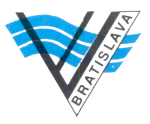
|
|
GABČÍKOVO – NAGYMAROS SYSTEM OF WATER WORKS |
|
|
|
|
|
Situation of the G-N SWW according to the 1977 treaty |
|
|
Situation of the reservoir in the original and temporary solutions |
Damage from postponing operation: In the initial phase of implementation of the investment, the event of its abandonment meant only the loss of the wasted investment resources, especially if the possibility exists to secure the aim of the investment in another suitable way. At an advanced stage of construction, the whole economy counts on the gain in appropriate capacities and contributions, while the possibility of implementing appropriate equivalent alternative solutions is not only practically limited by technical and time considerations, but is also economically disadvantageous because of the costs devoted to implementing the solution.
The effectiveness of completing the work increases in the course of construction, and before its introduction into operation is many times greater, than the originally determined effectiveness of the whole investment. The damage from stopping construction at this stage is therefore given by the value of the output not gained, increased by the resulting extra costs. In the given case, the value of the electricity not gained, in the quantity of about 2,000 million kWh per year (from this two thirds peak) alone represents a loss of 6,000 million Kčs per year. This loss may be reduced to about a third of the amount mentioned, by bringing at least the Gabčíkovo stage into operation. The total economic loss in the event of abandonment of the work, and implementation of an alternative solution, would reach over 100,000 million Austrian schillings (that is about 10,000 million USD) on the side of ČSFR alone, which represents the present value of the stream of costs required by this decision, for practically no gains. It is unquestionable that such a solution is absolutely unacceptable for Czecho-Slovakia.
The possibility of reaching a joint solution, acceptable to both sides: The offer of a joint completion of Gabčíkovo, officially submitted by the Hungarian side in December 1989, was already withdrawn in January 1990, immediately after stopping work on the temporary solution. In an attempt to preserve good neighbourly relations, the ČSFR used every opportunity for negotiations with the aim of of questioning the arguments for a unilateral abandonment of work. On its side, the environmental consequences of the G-N SWW were researched again. On the other hand, the party interrupting the Treaty (the validity of which it does not dispute) interrupted the activity of the Joint Expert Group, so that communication on the expert level, leading to checking of unsubstantiated views and the solution of controversial questions, was completely stopped. The offer of a joint request to the European Community for help in the framework of the PHARE programme, to solve the most serious of the resulting problems for the stocks of underground water, was rejected by the Hungarian side in October 1990. On the basis of all the evaluations carried out, and taking into account all the alternatives, including the proposed abandonment of the works, the governments of the ČSFR and the Slovak Republic decided to continue preparation of the temporary solution within the territory of the ČSFR, in January 1991. The government delegations met to appropriately solve the controversial questions of the Treaty after long delay in April 1991, up to two years after the unilateral abandonment of work. After violating the obligation to notify and consult before every unilateral step, the Hungarian side twice broke the obligation to negotiate with the aim of reaching a solution to the dispute, which international law generally lays down:
by a resolution of the parliament, the government was authorized only to negotiate the annulment of the Treaty, and returning the territory to its „original state",
by binding negotiating experts to completely predetermined ultimatum like conditions, also stopped work on fulfillment from the side of the ČSFR.
Under the limitations mentioned, a second negotiation between government delegations in July 1991 could contribute nothing and had contributed nothing to solving the dispute, so, at the end of July, the governments of the Slovak Republic and the ČSFR decided to implement the temporary solution, and in November 1991 started construction.
The possibilities of protection against non-fulfillment of the treaty by one party: The party fulfilling an international treaty has these possibilities of protection:
to interrupt fulfillment of the Treaty itself, but this is the aim of the partner;
to appeal to international arbitration, which is impossible without the cooperation of the partner, while the partner gives more evidence of its unwillingness to cooperate;
retaliatory arrangements in other economic or political areas, which would interrupt good neighbourly relations, without solving the given dispute;
to undertake defensive counter-measures, although also outside the framework of the valid treaty, in an attempt to reduce the resulting damage, by at least partial fulfillment of its aims. Since the countermeasures have the aim of forcing the partner to fulfillment, or to full compensation for damage, they must have a temporary character. At the same time, they may not have an offensive character, that is they may not cause serious harm to the partner's citizens or environment, or violate humanitarian principles.
Evaluation of the admissibility of the temporary solution: The Hungarian side did not allow the use of the dam constructed at Dunakiliti and the reservoir embankments on the territory of Hungary, and was not willing to complete its share of work on the Gabčíkovo stage. The basis of the temporary substitute solution is to bring Gabčíkovo into operation, by the building of structures entirely on the territory of the ČSFR, to reduce the area of the reservoir, to limit it to the area of the ČSFR, and allow its completion and connection with the supply canal constructed.
The Czecho-Slovak side was willing to abandon implementation of the temporary solution, if the Hungarian side appeared willing to fulfill its obligations, at least for the Gabčíkovo stage, and secure the embanking of the channel of the Danube in autumn 1991. At present with the first stage of work on the temporary solution practically complete, it will withdraw the temporary solution from operation, as soon as its partner returns to fulfillment of the treaty conditions. Full compensation for damages would in the given case require fulfillment of the aims of the Treaty, which cannot be achieved in another way.
Environmental effects of the temporary solution to the operation of Gabčíkovo: The environmental effects of the original solution of Gabčíkovo affected the Czecho-Slovak side to an essentially higher degree than the Hungarian side, since two thirds of the area of the reservoir, and especially because the whole canal is situated on protected, agricultural land of the ČSFR. This territory already cannot be returned to its original productive state, since without further damage to the environment, there is nowhere to put millions of cubic meters of construction gravel, the natural material to fill up the canal is lacking, and the soil needed to fertilize the returned land is already not available.
The activities accompanying the temporary solution will be equal to those in the original, since it is necessary to consider them mutually agreeable in the framework of the 1977 Treaty, or have more moderate effects on the Hungarian side, so that their effects cannot be considered a serious loss in the sense of international law, or a violation of humanitarian principles in any way.
Since the unilateral act declaring the annulment of the 1977 Treaty has not been accepted by one side, it is legally inactive and the Treaty is still fully valid.
The environmental effects of alternative C may therefore be recapitulated as follows:
The diversion of the navigational channel of the Danube onto the territory of the ČSFR is in harmony with the Treaty, and in the sense of its article no.22, does not change the state frontier, and does not interfere with the territorial integrity of Hungary in any way.
The transfer of water from the Danube is decided by the Treaty, carried out to mutual advantage, although the share of the costs and of the energy produced have changed as a result of the decision of the Hungarian side.
All provisions of the Treaty for the operation of the works and water economy will be maintained, or exceeded in favour of the natural environment.
By raising the level it will definitively stop the harmful process of systematic erosion of the bed of the Danube and deepening of the surface of the underground water.
To simultaneously secure the addition of water to the Moson branch of the Danube,
and increase the feeding of underground water by filtering from the reservoir - in relation to the configuration of the underlying deeper layers will be fed by filtering from the upper part of the reservoir under Bratislava, while seepage from the lower part of the reservoir will dilute the upper, at present very impure layers of underground water.
Construction of transfer structures will enable the optimal addition of water to the old channels and systems of dead branches, according to the need for the creation of artificial floods.
During operation a system of observation buildings, systematically monitor and evaluate the level of the surface, and the quality of the underground water in the district. Any aberration will be detected early, and if necessary appropriate arrangements secured.
As a result of the facts mentioned, the bringing of Gabčíkovo into operation not only secures the fulfillment of the aims of the investment, to the advantage of both sides, but the accompanying activities will have a mainly positive influence on the environment of Hungarian territory, so that these counter-measures may be considered not only appropriate, but at the same time also environmentally demanding.
|
|
Section of the dam for bypass
|
||||||||||||||||||||||||||||||||||
|
|
|||||||||||||||||||||||||||||||||||
View of the buildings of the temporary solution
|
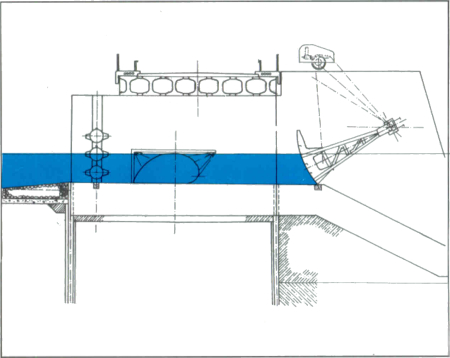
|
||||||||||||||||||||||||||||||||||
The 1977 Treaty supposed the release of a biological flow of 50 m3s-1 into the old channel. With such a flow into the empty, strongly deepened channel (almost 2 m deeper than in 1977), in periods of low flow the Danube would unfavourably lower the level of the underground water in the surrounding area, by its drainage affect. Therefore the possibility was studied of reducing this effect by proposed weir in the channel, which would create a level corresponding to the natural flow of about 1350 m3s-1, by raising the biological flow, for example to 350 m3s-1. In the sense recommended by biologists the weirs would be completed with bypasses allowing the migration of fish. Although even this level still does not reach the boundary between the underlying gravel and the soil layer of the river side forest, it is calculated that with periodical raising of the biological flow to about 13 m3s-1, by which accumulated sediments on the bottom would be washed away, the root systems of trees would be reached, and the channel connected with the system of interconnected levels of dead branches. The latest results of research, carried out in cooperation with Danish and Dutch companies, shows the considerable importance of varying the level in the old bed, favourably influencing the quality of the neighbouring underground water. In such a solution the steps are less, but with a spillway gate, while the gradients created may be used for the production of electric energy.
The construction of stages in the old bed is required in the interests of creating optimal conditions for the ecosystem of the inland delta on both sides of the Danube and be carried out only on the basis of bilateral agreements. One possible solution considers the use of the Dunakiliti stage, and the construction of two further stages, perhaps in kilometres 1821 and 1831 of the river, by which raising of the level would secure the permanent watering of the root systems of the river side forest, and connection of the old channel with the system of dead branches. Variation of the level in the period apart from the passage of floods and periodical washing out may be secured by occasional release of these small reservoirs.
|
|
Aim of the work
Flood Defence
Aim: To prevent the catastrophes of the years 1954 and 1965.
Means: To achieve the division of flood peaks in the section of canal and reduce the flow in the channel of the Danube to a level appropriate to the ground-underlying the flood embankments. Below Palkovič to raise the flow capacity by deepening the channel, and in the area of the Nagymaros reservoir to increase security by reconstruction of embankments and making the relatively shallow underlying ground less permeable by means of underground walls.
Improving the Navigational Parameters of the Danube Water Way
Aim: To secure the parameters of the Danube water way recommended by the Danube Commission - a navigable channel 180 m wide and 3,5 m deep.
Means: To transfer the navigable channel to the canal in the Gabčíkovo section. To flood fords and thresholds in the Nagymaros section by raising the level. To deepen the channel in the section below Palkovič as well.
Aim: To gain for our country a permanent source of clean electricity by using the water energy potencial of the Danube.
Means: Construction of two hydroelectric power stations - Gabčíkovo HPS with an output of 720 MW, and an annual production of perhaps 3,000 million KWh (mostly peak energy), and Nagymaros HSP with an output of 158 MW and an annual production of 1,000 million KWh. Together with the existing hydroelectric power stations, coverage of over 20 % of the needs of the Slovak Republic will be secured from domestic, inexhaustible, environmentally friendly sources.
Aim: The preservation of river-side forest and additional arms of the Danube before drying up and the prevention of further harmful effects of the constant and accelerating deepening of the bed of the Danube, and decline in the level in periods of low flow.
Means: Prevention of the process of erosion of the bed by raising the level and slowing the current. Construction of small electric power stations watering the old channel of the Danube and its branches and dams allowing the creation of artificial floods in the system of dead branches in the event of need.
On stocks of underground water: The increased amount of water - from the end of the reservoir below Bratislava to the deeper layers used by waterworks, and from the middle and lower parts of the reservoir to the upper, at present very impure layers, which clean the water by filtering it. The penetration of filtered water directly to the deeper layers and the pulling down of organic material is improbable, in relation to the local conditions (permeability of the layers is ten times greater in a horizontal, than in a vertical direction).
On the level of the surface of the underground water: In the Gabčíkovo section of the reservoir, there will be a favourable increase in the very low declining surface of the underground waters, an increase in the inclination of their surface, an increase in the dynamic of their movement and their renewal. In the section of the supply canal, it is also possible to influence the level of the underground water, by regulation of the water level in the filtration canals. In the section of the outflow canal, there will be a decline of the level of the underground water, the influence of which may be balanced by the dense network of irrigation canals. In the given climatic conditions, irrigation is a condition of the intensification of agricultural production even without water works. In the Nagymaros section, the seepage canals and pumping stations exclude an unfavourable raising of the level up to the ground and they create conditions for the desalination of soils and irrigation.
On water transport and ports: The gravel fords on the Rajka - Gönyű section, as the greatest barriers to navigation, are bypassed by the canal. The creation of the Gabčíkovo allows access and use of the Bratislava harbour throughout the year and a halt to the erosion processes threatening navigation. The Nagymaros reservoir secures good conditions for navigation above the stage and deepens the channel of the Danube.
On nature and the ecosystem of the Danube Delta: The decline of the level of the underground water will stop and the possibility of adding water in the required quantity throughout the year will be secured. As a definitive solution, construction of barrages or dams is considered, on the old course of the Danube, which will secure together with increased biological flow, permanently raised levels, as well the possibility of their cyclic variation. The permanent addition of water to the drying Moson branch will enable gradual purification of its channel and surroundings.
On agricultural production: The taking of 3900 hectares of agricultural land, especially for the canal, is balanced by the protection of 3000 hectares of land from inundation, and the fertilization of a further 2000 hectares of unproductive land. In the whole area, favourable conditions will be created for the intensification of agricultural production with the help of regulating the level of the underground water and supplying pure water for additional irrigation.
On forestry production and the life of forest animals: The taking of 3400 hectares of forest land and its clearance is a price, which must be paid for the many important contributions and activities of the G-N SWW. Optimum conditions will be created for the remaining river-side forest, which is at present threatened by gradual drying. Demands to improve the living conditions of forest animals will be fully respected.
On fisheries and fishing for sport: The water regime in the reservoir and canals will be transformed. Resources for the construction of ponds for fish breeding were included in the framework of the budget for the water works. Optimal conditions, better than at present, will be created in the old channel, the dead branches and the Moson branch of the Danube. The required possibility for the migration of fish between the dead branches and the Danube, or along the old channel, will be secured after the construction of weirs.
On the population: During construction, up to 5,000, mostly local people found employment. The construction includes two recreational sports centres with a capacity for about 100,000 daily visitors. At least 5,000 permanent jobs, and the possibility of selling domestic products will be created. These recreational centres, with the possibility of cultivating cycling and water sports are extraordinarily necessary in the surroundings of Bratislava, and will also serve a wider region, as well as foreign tourists. With basic conditions for future economic development of the region, definitive protection against flooding and the discharge of internal waters, which also caused flooding, is created.
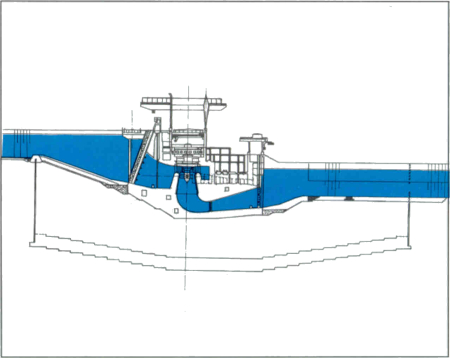 |
Section of the hydroelectric power station
Parameters Main structures:
|
||||||||||||||||||||||||||||||
|
|
|||||||||||||||||||||||||||||||
Typical section of embankments – Reservoir:
|
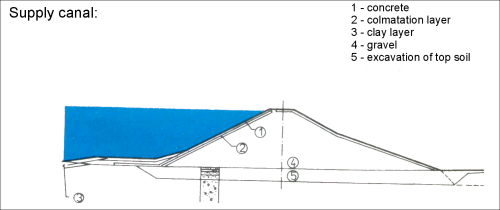 |
||||||||||||||||||||||||||||||
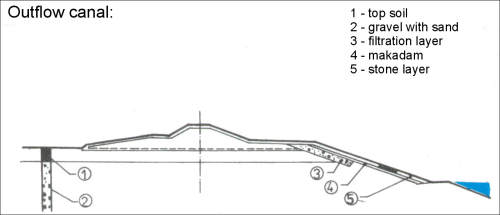 |
|||||||||||||||||||||||||||||||
It was decided in the treaty of 1977, that in spite of the natural division of primary hydro-electric potencial by 55:45 percent in favour of Czecho-Slovakia, the costs of building work would be divided in the proportion of 50:50 percent, and the output of energy would be divided in the same proportions. Further contributions were considered „national" in character and their balancing was not considered. Responsibility for the environmental consequences is common. The treaty is anchored in the common obligation to minimalize the necessary negative results of operational activity. Originally the working out of common economic evaluation was supposed, so methods were also worked out. The implementation of this intention was abandoned because of the unwillingness of the Hungarian side, so compensation for different claims of losses in the course of construction, caused by considerable differences in the times of implementation of parts of the works in Czecho-Slovakia and Hungary, were not resolved.
The last complete evaluation of the economic effectiveness of the Czecho-Slovak parts of the investment were worked out in 1980. At an average price of mostly peak energy of about 340 Kčs/MWh, it made up a share of the production of energy of 639 million Kčs per year, which represented perhaps 38 % of the total national economic share calculated at 1688 million Kčs per year. At a total, one time, cost of 13,800 million Kčs, or including interest (8 %) 18,700 million Kčs and operating costs of 120 million Kčs, the internal profit appeared of percent investment VVP = 6.3 % and the period of payment of perhaps 12 years.
In 1980, the price of energy used, derived from the subsidized price of fuel, incompletely calculated costs for safe and environmentally friendly thermal and nuclear power stations, so in this assessment, the contribution from energy production was significantly underestimated and did not cover extensive reproduction (annual costs represented perhaps 537 Kčs/MWh). Since then the cost of building work significantly increased, as also appeared in the evaluation of the non-energy shares (from protection of the land, from improving navigational conditions, from supplies of water and gravel, from recreational and sporting use, simultaneous improvement of the local infrastructure and development of the region), but not to such an extent as the prince of electric energy, which was gradually equalized with prices on the European market. Since the majority of one-time expenses were already invested at the preceeding lower price levels, the effectiveness of the works grew, in spite of the expected reduction of the energy effect (as a result of the proposed increase of sanitary flow).
For example at 1989 price levels, the total one-time cost increased to 18,400 million Kčs, or including interest to 25,000 million Kčs, and the operating costs to 160 million Kčs per year. At an energy price of 1500 Kčs/MWh, the contribution from production of energy would be 2,814 million Kčs per year, which from a total contribution of 4,228 million Kčs per year already represents about 67 %. The internal yield of investment has doubled and the return shortened by half. Indeed the higher cost of energy and the higher proportion of energy contributions cause an increase of the measurable annual costs to 1200 Kčs/MWh, but these already reach only 80 % of the cost of energy. In 1989, contributions from the production of energy alone would have secured the return of the whole investment in a period shorter than 10 years. As a result of the present impossibility of completing construction at Nagymaros, a new evaluation of the whole G-N SWW was not done.
In evaluating Gabčíkovo alone, without Nagymaros, the equal division of the electricity produced does not apply. The natural division of primary hydroelectric potential in this section is about 62:38 percent in favour of Czecho-Slovakia, but in the event of the common completion of this stage, the share of the Hungarian side in the work would reach only 35%, which would also determine the claim for equal division of the energy produced. At 1989 price levels, at JN = 15,400 million Kčs (including interest 21,300 million Kčs), NP = 144 million Kčs per year, and at a price of energy of 1500 Kčs/MWh, that is contributions from the production of electricity, a total of 2,658 million Kčs per year, VVP would reach about 12 % and return of one-time expenses in about 6 years.